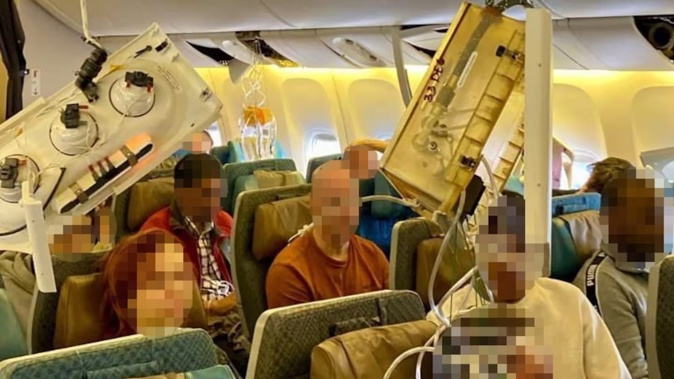
The Singapore Airlines jetliner that hit severe turbulence last week went through huge swings in gravitational force in less than five seconds, likely causing the injuries to people who weren’t buckled into their seats, according to a preliminary report on Wednesday by Singapore’s Transport Ministry.
The plane dropped 54m in less than one second, which “likely resulted in the occupants who were not belted up to become airborne” before falling back down, the Transport Ministry said.
A 73-year-old British man died of a suspected heart attack and dozens were injured after the Boeing 777, which was flying from London to Singapore on May 21, ran into turbulence that hurled people and items around the cabin. The plane, with 211 passengers and 18 crew members, made an emergency landing in Bangkok.
Singapore’s Transport Ministry said investigators, including those from the US National Transportation Safety Board, Federal Aviation Administration and Boeing, had compiled a chronology of events based on the preliminary analysis of the flight’s data and cockpit voice recorders.
Early findings show that as the plane cruised at about 11,277 metres over southern Myanmar, it began to experience slight vibration due to changes in the gravitational force, the ministry said. The jet’s altitude increased — likely caused by an updraft, not by any action of the pilots — causing the autopilot system to push the plane back down to the selected altitude, the report said.
The pilots also noticed an uncommanded increase in airspeed, which they tried to check by extending panels called speed brakes, and “a pilot called out that the fasten seat belt sign had been switched on”.
The report showed one swing from positive 1.35G to negative 1.5G, within 0.6 seconds would have “likely resulted in the occupants who were not belted up to become airborne.” This three ‘G’ swing is the equivalent change of three times normal gravity within a split second.

An Australian passenger who was injured by turbulence on flight SQ321 flying from London’s Heathrow airport to Singapore. Photo / Sakchai Lalit, AP
A few seconds later, the plane entered the sharp drop that caused unbelted passengers to come out of their seats before falling back.
“This sequence of events likely caused the injuries to the crew and passengers,” the report said.
- Fatal turbulence: Aviation experts reveal 'life-or-death' thing passengers need to do
- Plane drops seven thousand feet, dozens left injured
- Kiwi in ICU in Thai hospital after fatal Singapore Airlines turbulence
- Deadly turbulence: 2 Kiwis hospitalised after Singapore Airlines flight
The pilots disengaged the autopilot to stabilise the plane, the report said, and flew it manually for 21 seconds before going back to autopilot.
The plane made a normal, controlled descent and didn’t encounter further turbulence until it landed in Bangkok almost an hour later, the ministry said, adding that investigations are ongoing.
Passengers have described the “sheer terror” of the aircraft shuddering, loose items flying and injured people lying paralysed on the floor of the plane.
Twenty-six people remained hospitalised in Bangkok on Wednesday. Hospital authorities earlier said injuries included spinal or spinal cord damage, skull or brain injuries and damage to bones or internal organs.
It was unclear what caused the turbulence. Most people associate turbulence with heavy storms, but the most dangerous type is so-called clear air turbulence. Wind shear can occur in wispy cirrus clouds or even in clear air near thunderstorms, as differences in temperature and pressure create powerful currents of fast-moving air.
According to a 2021 report by the US National Transportation Safety Board, turbulence accounted for 37.6 per cent of all accidents on larger commercial airlines between 2009 and 2018. The Federal Aviation Administration has said there were 146 serious injuries from turbulence from 2009 to 2021.
- Associated Press with additional reporting
Take your Radio, Podcasts and Music with you









